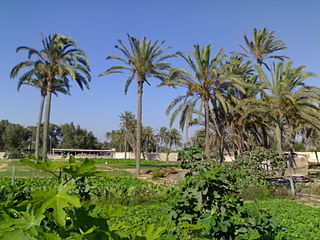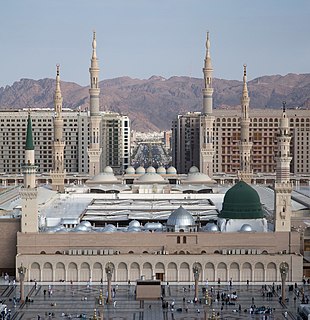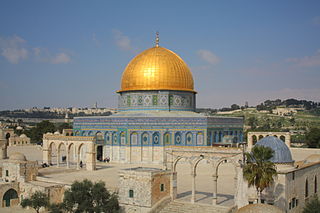
A mosque, also called masjid, is a place of worship for Muslims. Any act of worship that follows the Islamic rules of prayer can be said to create a mosque, whether or not it takes place in a special building. Informal and open-air places of worship are called musalla, while mosques used for communal prayer on Fridays are known as jāmiʿ. Mosque buildings typically contain an ornamental niche (mihrab) set into the wall that indicates the direction of Mecca (qiblah), ablution facilities and minarets from which calls to prayer are issued. The pulpit (minbar), from which the Friday (jumu'ah) sermon (khutba) is delivered, was in earlier times characteristic of the central city mosque, but has since become common in smaller mosques. Mosques typically have segregated spaces for men and women. This basic pattern of organization has assumed different forms depending on the region, period and denomination.

Cyrenaica is the eastern coastal region of Libya. Also known as Pentapolis in antiquity, it formed part of the Roman province of Crete and Cyrenaica, later divided into Libya Pentapolis and Libya Sicca. During the Islamic period, the area came to be known as Barqa, after the city of Barca.

Awjila is an oasis town in the Al Wahat District in the Cyrenaica region of northeastern Libya. Since classical times it has been known as a place where high quality dates are farmed. From the Arab conquest in the 7th century, Islam has played an important role in the community. The oasis is located on the east-west caravan route between Egypt and Tripoli, and on the north-south route between Benghazi and the Sahel between Lake Chad and Darfur, and in the past was an important trading center. It is the place after which the Awjila language, an Eastern Berber language, is named. The people cultivate small gardens using water from deep wells. Recently, the oil industry has become an increasingly important source of employment.

Benghazi is a city in Libya. Located on the Gulf of Sidra in the Mediterranean, Benghazi is a major seaport and the second-most populous city in the country, as well as the largest city in Cyrenaica, with an estimated population of 632,937 in 2019.

Al-Masjid an-Nabawi, known in English as The Prophet's Mosque, and also known as Al Haram, Al Haram Al Madani and Al Haram Al Nabawi by locals, is a mosque built by the Islamic prophet Muhammad in the city of Medina in the Al Madinah Province of Saudi Arabia. It was the second mosque built by Muhammad in Medina, after Masjid Quba'a, and is now one of the largest mosques in the world. It is the second holiest site in Islam, after the Masjid al-Haram in Mecca. It is generally open regardless of date or time, and has only been closed to visitors once in modern times, as Ramadan approached during the 2020 COVID-19 pandemic.

Misrata is a city in the Misrata District in northwestern Libya, situated 187 km (116 mi) to the east of Tripoli and 825 km (513 mi) west of Benghazi on the Mediterranean coast near Cape Misrata. With a population of about 881,000, it is the third-largest city in Libya, after Tripoli and Benghazi. It is the capital city of the Misrata District and has been called the trade capital of Libya. The harbor is at Qasr Ahmad.

Derna is a port city in eastern Libya. It has a population of 100,000–150,000. It was the seat of one of the wealthiest provinces in the Barbary States, and remains the capital of the Derna District, with a much smaller area. Derna has a unique environment among Libyan cities, as it lies between green mountains, the Mediterranean Sea, and the desert. The city is also home to people of mixed origins.

Zliten is a city in Murqub District of Libya. It is located 160 km to the east of Tripoli.

Ajdabiya is a town in and capital of the Al Wahat District in northeastern Libya. It is some 150 kilometres (93 mi) south of Benghazi. From 2001 to 2007 it was part of and capital of the Ajdabiya District. The town is divided into three Basic People's Congresses: North Ajdabiya, West Ajdabiya and East Ajdabiya.
The Turks in Libya, also commonly referred to as Libyan Turks, Turco-Libyans, and Turkish-Libyans are the ethnic Turks who live in Libya. According to the last census which allowed citizens to declare their ethnicity, the Turkish minority formed the third largest ethnic group in the country, after the Arabs and Berbers, and they mainly live in Misrata, Tripoli, Zawiya, Benghazi and Derna.

Lists of mosques cover mosques, places of worship for Muslims. The lists include the most famous, largest and oldest mosques, and mosques mentioned in the Quran, as well as lists of mosques in each region and country of the world. The major regions, Africa, Americas, Asia, Europe and Oceania are sorted alphabetically. The sub-regions, such as Northeast and Northwest Africa in Africa, and Arabia and South Asia in Asia, are sorted by the dates in which their first mosques were reportedly established, more or less, barring those that are mentioned by name in the Quran.
The following is a timeline of the history of the city of Tripoli, Libya.

The Fatimid architecture that developed in the Fatimid Caliphate (909–1167 CE) of North Africa combined elements of eastern and western architecture, drawing on Abbasid architecture, Byzantine, Ancient Egyptian, Coptic architecture and North African traditions; it bridged early Islamic styles and the medieval architecture of the Mamluks of Egypt, introducing many innovations.

The Atiq Mosque is a mosque in the oasis village of Awjila, in the Sahara desert of the Cyrenaica region of eastern Libya. The community dates back to classical times. Since being taken by the Arabs in the seventh century, Islam has always played a central role in the life of Awjila. The 12th-century mosque, the oldest in the region, has unusual conical domes made of mudbrick and limestone that provide light and ventilation.

Umayyad architecture developed in the Umayyad Caliphate between 661 and 750, primarily in its heartlands of Syria and Palestine. It drew extensively on the architecture of other Middle Eastern civilizations and that of the Byzantine Empire, but introduced innovations in decoration and new types of building such as mosques with mihrabs and minarets. It was also inspired by Islamic architecture, and they made mosques with vibrant colours and used geometric designs because representational art wasn't allowed.

Masjid al-Haram, also known as the Great Mosque of Mecca, is a mosque that surrounds the Kaaba in Mecca, in the Makkah Province of Saudi Arabia. It is a site of pilgrimage in the Hajj, which every Muslim must do at least once in their lives if able, and is also the main phase for the ʿUmrah, the lesser pilgrimage that can be undertaken any time of the year. The rites of both pilgrimages include circumambulating the Kaaba within the mosque. The Great Mosque includes other important significant sites, including the Black Stone, the Zamzam Well, Maqam Ibrahim, and the hills of Safa and Marwa.
The following is a timeline of the history of the city of Benghazi, Libya.

The Sword of Islam was a ceremonial melee weapon given in 1937 to Benito Mussolini, who was pronounced as the Protector of Islam.


















